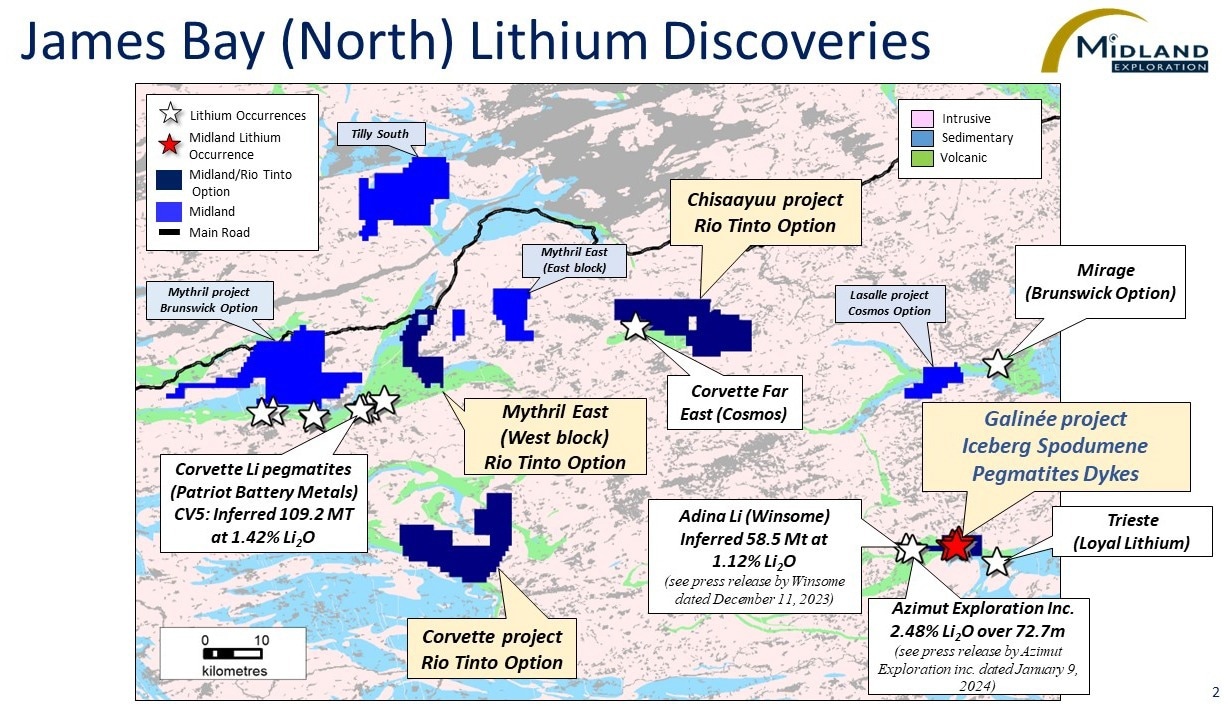Reviewed by Lexie CornerMar 20 2024
Midland Exploration Inc., in collaboration with Rio Tinto Exploration Canada Inc., is delighted to announce the initiation of a maiden drilling campaign on the Galinée project, located approximately 8 km east of the Adina lithium deposit held by Winsome Resources.
 James Bay (North) Lithium Discoveries. Image Credit: Midland Exploration Inc.
James Bay (North) Lithium Discoveries. Image Credit: Midland Exploration Inc.
Midland owns the Galinée project, which is subject to an option agreement signed with RTEC in June 2023.
- Maiden 5.8M CAD drilling program targeting the Iceberg Showing to start on the Galinée project
- Iceberg Showing consists of spodumene-bearing pegmatite dykes discovered across at least 600 m of strike length, with high-grade grab samples grading up to 7.2% Li2O
- An extra 1.3 M CAD exploration program for the ten optioned properties, which include Komo and Shire
The Iceberg spodumene showing will be the subject of a 5.8 million CAD maiden diamond drilling campaign, which will begin in early April. This program aims to determine the grade and geometry of the Iceberg spodumene pegmatites discovered in 2023 by drilling along multiple fences.
In addition to drilling, a summer surface exploration campaign is planned for the Galinée project over targets identified by the 2023 high-resolution airborne magnetic and radiometric survey, which will locate structures that might house spodumene pegmatites.
This summer’s exploration activity is part of a massive 1.3 million CAD reconnaissance exploration effort that will cover all ten (10) option agreement projects (Galinée, Corvette, Mythril East, Chisaayuu, Komo, Shire, Moria, Picard, Warp, and Sulu).
The Iceberg Showing comprises many outcrops of spodumene interspersed with granodiorite and amphibolite and spans a 600 m east-west strike. As reported in a press statement from Midland dated November 2nd, 2023, high-grade grab samples on the Iceberg yielded up to 7.2 % Li2O, with six samples grading between 5.0 % and 7.2 % Li2O.
Iceberg South and Iceberg Southwest are two additional lithium showings that are situated 500 and 900 m away from the main Iceberg showing, respectively. Three (3) samples with grades ranging from 3.0 % to 3.6 % Li2O were obtained from the spodumene-bearing outcrop in the Iceberg Southwest. 4.1 % Li2O was retrieved from a boulder containing spodumene 100 m west of this showing. A pegmatite subcrop forms the Iceberg South Showing, which yielded an unusual lithium value of 0.7 % Li2O.
The Galinée project is situated around 4 km directly east of Winsome’s Adina performance. This showing is characterized by a significant structure that most likely controlled the emplacement of pegmatites at the Adina showing. It is situated at the contact between felsic intrusives to the north and amphibolites of the Trieste Formation to the south.
The Iceberg lithium showing was found along the same extremely favorable contact zone that stretches over seven kilometers across the site.
The James Bay lithium deposit (Arcadium Lithium) lies around 20 km west of the Komo Project. Both the James Bay lithium deposit and Komo are situated where the La Grande and Nemiscau geological subprovinces converge. This contact is a significant feature spanning about 30 km on the Komo project, and it is crucial to the emplacement of the James Bay lithium host pegmatite.
The Whabouchi lithium deposit is situated around 60 km southwest of Shire in the amphibolites of the Lac des Montagnes geological Group, where the Shire project is situated. A pegmatite intrusion associated with the Senay granitic suite, also present in the Shire project, is a defining feature of the Whabouchi lithium deposit.
Additionally, this project is situated near a significant structure, the boundary between the La Grande and Opatica geological subprovinces, that might be important for the emplacement of lithium-bearing pegmatites in the region.
Midland undertook a regional statistical treatment and discovered several lake bottom sediment lithium anomalies on the Corvette, Chisaayuu, Komo, Shire, Picard, Warp, and Sulu projects.